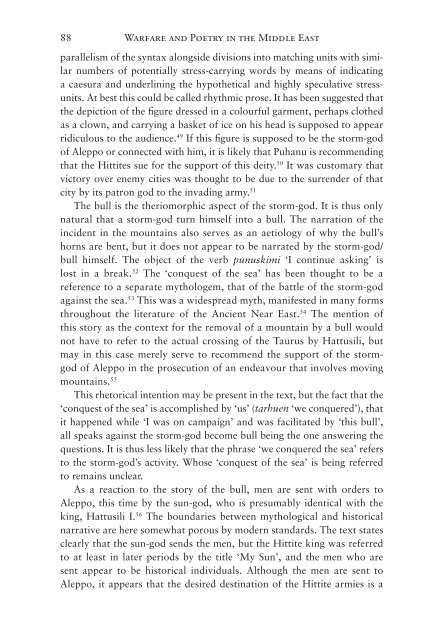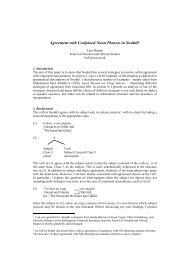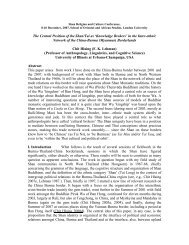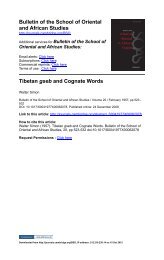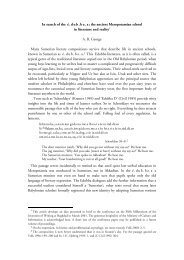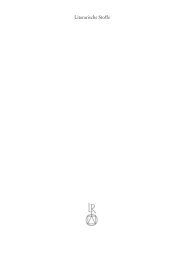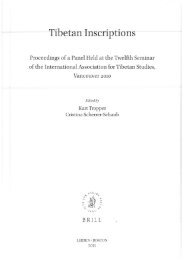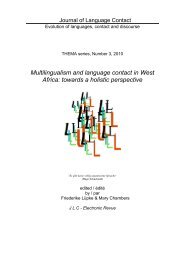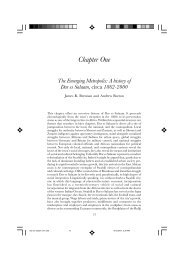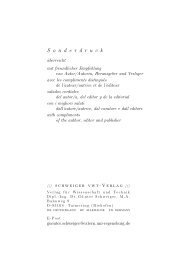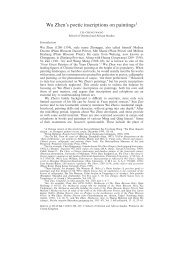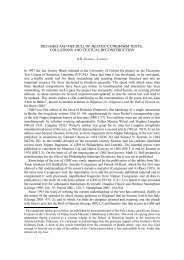Download (549Kb) - SOAS Research Online
Download (549Kb) - SOAS Research Online
Download (549Kb) - SOAS Research Online
Create successful ePaper yourself
Turn your PDF publications into a flip-book with our unique Google optimized e-Paper software.
88 Warfare and Poetry in the Middle East<br />
parallelism of the syntax alongside divisions into matching units with similar<br />
numbers of potentially stress-carrying words by means of indicating<br />
a caesura and underlining the hypothetical and highly speculative stressunits.<br />
At best this could be called rhythmic prose. It has been suggested that<br />
the depiction of the figure dressed in a colourful garment, perhaps clothed<br />
as a clown, and carrying a basket of ice on his head is supposed to appear<br />
ridiculous to the audience. 49 If this figure is supposed to be the storm-god<br />
of Aleppo or connected with him, it is likely that Puhanu is recommending<br />
that the Hittites sue for the support of this deity. 50 It was customary that<br />
victory over enemy cities was thought to be due to the surrender of that<br />
city by its patron god to the invading army. 51<br />
The bull is the theriomorphic aspect of the storm-god. It is thus only<br />
natural that a storm-god turn himself into a bull. The narration of the<br />
incident in the mountains also serves as an aetiology of why the bull’s<br />
horns are bent, but it does not appear to be narrated by the storm-god/<br />
bull himself. The object of the verb punuskimi ‘I continue asking’ is<br />
lost in a break. 52 The ‘conquest of the sea’ has been thought to be a<br />
reference to a separate mythologem, that of the battle of the storm-god<br />
against the sea. 53 This was a widespread myth, manifested in many forms<br />
throughout the literature of the Ancient Near East. 54 The mention of<br />
this story as the context for the removal of a mountain by a bull would<br />
not have to refer to the actual crossing of the Taurus by Hattusili, but<br />
may in this case merely serve to recommend the support of the stormgod<br />
of Aleppo in the prosecution of an endeavour that involves moving<br />
mountains. 55<br />
This rhetorical intention may be present in the text, but the fact that the<br />
‘conquest of the sea’ is accomplished by ‘us’ (tarhuen ‘we conquered’), that<br />
it happened while ‘I was on campaign’ and was facilitated by ‘this bull’,<br />
all speaks against the storm-god become bull being the one answering the<br />
questions. It is thus less likely that the phrase ‘we conquered the sea’ refers<br />
to the storm-god’s activity. Whose ‘conquest of the sea’ is being referred<br />
to remains unclear.<br />
As a reaction to the story of the bull, men are sent with orders to<br />
Aleppo, this time by the sun-god, who is presumably identical with the<br />
king, Hattusili I. 56 The boundaries between mythological and historical<br />
narrative are here somewhat porous by modern standards. The text states<br />
clearly that the sun-god sends the men, but the Hittite king was referred<br />
to at least in later periods by the title ‘My Sun’, and the men who are<br />
sent appear to be historical individuals. Although the men are sent to<br />
Aleppo, it appears that the desired destination of the Hittite armies is a<br />
03_Warfare&Poetry_Ch3_073-098.indd 88 06/02/2013 10:15


